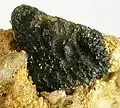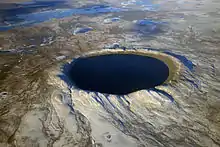Moldavite
Moldavite (Czech: Vltavín) is a forest green, olive green or blue greenish vitreous silica projectile rock formed by a meteorite impact probably in southern Germany (Nördlinger Ries Crater)[3] that occurred about 15 million years ago.[4] It is a type of tektite.
| Moldavite | |
|---|---|
 Moldavite from Zatačka, Bohemia, Czech Republic | |
| General | |
| Category | Glass |
| Formula (repeating unit) | SiO2(+Al2O3) |
| Crystal system | Amorphous |
| Identification | |
| Color | Forest green |
| Mohs scale hardness | 5.5[1] to 7[2] |
| Luster | Vitreous |
| Diaphaneity | Opaque, translucent, transparent |
| Specific gravity | 2.32 to 2.38 |
| Optical properties | Isotropic |
| Refractive index | 1.48 to 1.54 |
| Birefringence | None |
| Pleochroism | Absent |
| Dispersion | None |
| References | [1] |
Early studies
Moldavite was introduced to the scientific public for the first time in 1786 as "chrysolites" from Týn nad Vltavou in a lecture by Josef Mayer of Prague University, read at a meeting of the Bohemian Scientific Society (Mayer 1788). Zippe (1836) first used the term "Moldavite", derived from the Moldau (Vltava) river in Bohemia (the Czech Republic), from where the first described pieces came.[5]
Origin
In 1900, Franz Eduard Suess pointed out that the gravel-size moldavites exhibited curious pittings and wrinkles on the surface, which could not be due to the action of water, but resembled the characteristic markings on many meteorites. He attributed the material to a cosmic origin and regarded moldavites as a special type of meteorite for which he proposed the name of tektite. Because of their difficult fusibility, extremely low water content, and chemical composition, the current consensus among earth scientists is that moldavites were formed about 14.7 million years ago during the impact of a giant meteorite in the present-day Nördlinger Ries crater. Splatters of material that was melted by the impact cooled while they were actually airborne and most fell in Bohemia. Currently, moldavites have been found in an area that includes southern Bohemia, western Moravia, the Cheb Basin (northwest Bohemia), Lusatia (Germany), and Waldviertel (Austria).[6] Isotope analysis of samples of moldavites have shown a beryllium-10 isotope composition similar to the composition of Australasian tektites (australites) and Ivory Coast tektites (ivorites).[7]
Ninety-nine percent of all moldavite finds have come from the South Bohemian localities, one percent were found in South Moravian localities. Only tens of pieces were found in the Lusatian area (near Dresden), Cheb basin area (West Bohemia) and Northern Austria (near Radessen). Principal occurrences of moldavites in Bohemia are associated with Tertiary sediments of the České Budějovice and Třeboň Basins. The most prominent localities are concentrated in a NW-SE strip along the western margin of the České Budějovice Basin. The majority of these occurrences are bound to the Vrábče Member and Koroseky Sandy Gravel. Prominent localities in the Třeboň Basin are bound to gravels and sands of the Domanín Formation.
In Moravia, moldavite occurrences are restricted to an area roughly bounded by the towns of Třebíč, Znojmo and Brno. The colour of Moravian moldavites usually differs from their Bohemian counterparts, as it tends to be brownish. Taking into account the number of pieces found, Moravian localities are considerably less productive than the Bohemian ones; however, the average weight of the moldavites found is much higher. The oldest (primary) moldavite-bearing sediments lie between Slavice and Třebíč. The majority of other localities in southern Moravia are associated with sediments of Miocene as well as Pleistocene rivers that flowed across this area more or less to the southeast, similar to the present streams of Jihlava, Oslava and Jevišovka.
Properties
The chemical formula of moldavite is SiO2(+Al2O3). Its properties are similar to those of other types of glass, and reported Mohs hardness varies from 5.5[1] to 7.[2] Moldavite can be transparent or translucent with a mossy green color, with swirls and bubbles accentuating its mossy appearance. Moldavites can be distinguished from green glass imitations by observing their worm-like inclusions of lechatelierite.[1]
Use
The total amount of moldavite scattered around the world is estimated at 275 tons.[8]
There are three grades of moldavite: high quality, often referred to as museum grade, medium quality and regular grade. All three grades can be told apart by their appearance. The regular grade pieces are usually darker and more saturated in their green colour, and the surface is seen as closely spaced pitting or weathering. This type sometimes appears to have been broken apart from a larger chunk.
The museum grade has a distinct fern-like pattern and is much more translucent than the regular grade. There is usually a fairly big difference in the price between the two. High-quality moldavite stones are often used for hand-crafted jewellery.[8]
There is a moldavite museum, Muzeum Vltavínů, in Český Krumlov, Czech Republic.[9] The Moldavite Association was established in Ljubljana, Slovenia in 2014. The association researches, exhibits and promotes moldavites and other tektites around the world and has member geologists from more than 30 countries worldwide.[10]
 Rough moldavite
Rough moldavite From Moldavia, Czech Republic
From Moldavia, Czech Republic Moldavite Czech Republic
Moldavite Czech Republic Moldavite Czech Republic
Moldavite Czech Republic
References
- "Moldavite". Gemdat.org. Retrieved 6 February 2016.
- O'Keefe A., John. "Tektites and their Origin"., Goddard Space Centre, NASA. Retrieved 9 December 2017.
- Artemieva, N., Pierazzo, E. and Stöffler, D. (2002). "Numerical modeling of tektite origin in oblique impacts: Implication to Ries-Moldavites strewn field" (PDF). Bulletin of the Czech Geological Survey. www.geology.cz. 77: 303–311.CS1 maint: multiple names: authors list (link)
- Earth Impact Database: Ries Archived 2016-03-04 at the Wayback Machine at www.passc.net/EarthImpactDatabase, Accessed 5 February 2018
- "Moldavite" at Mindat.org, Accessed 5 February 2018
- Trnka, M.; Houzar, S. (2002). "Moldavites: a review PDF" (PDF). Bulletin of the Czech Geological Survey. 77 (4): 283–302.
- Serefiddin, F.; Herzog, G. F.; Koeberl, C. (2007). "Beryllium-10 concentrations of tektites from the Ivory Coast and from Central Europe: Evidence for near-surface residence of precursor materials" (PDF). Geochimica et Cosmochimica Acta. 71 (6): 1574–1582. Bibcode:2007GeCoA..71.1574S. doi:10.1016/j.gca.2006.12.007.
- Moldavite Gemstone Information: About Moldavite - History and Introduction "total... estimated to be about 275 tons..." and "Gem-quality moldavite is typically offered in two grades; regular and museum grade" at gemselect.com, Accessed 29 January 2018
- MUZEUM VLATVÍNŮ, MOLDAVITE MUSEUM, Český Krumlov, Southern Bohemia, Czech Republic, at tektites.co.uk Accessed 29 January 2018
- Moldavite Association at starstones.com
| Wikisource has the text of the 1911 Encyclopædia Britannica article Moldavite. |
![]() This article incorporates text from a publication now in the public domain: Chisholm, Hugh, ed. (1911). "Moldavite". Encyclopædia Britannica. 18 (11th ed.). Cambridge University Press. p. 652.
This article incorporates text from a publication now in the public domain: Chisholm, Hugh, ed. (1911). "Moldavite". Encyclopædia Britannica. 18 (11th ed.). Cambridge University Press. p. 652.
- J. Baier: Zur Herkunft und Bedeutung der Ries-Auswurfprodukte für den Impakt-Mechanismus. - Jber. Mitt. oberrhein. geol. Ver., N. F. 91, 9-29, 2009.
- J. Baier: Die Auswurfprodukte des Ries-Impakts, Deutschland, in Documenta Naturae, Vol. 162, München, 2007. ISBN 978-3-86544-162-1
External links
| Wikimedia Commons has media related to Moldavite. |


